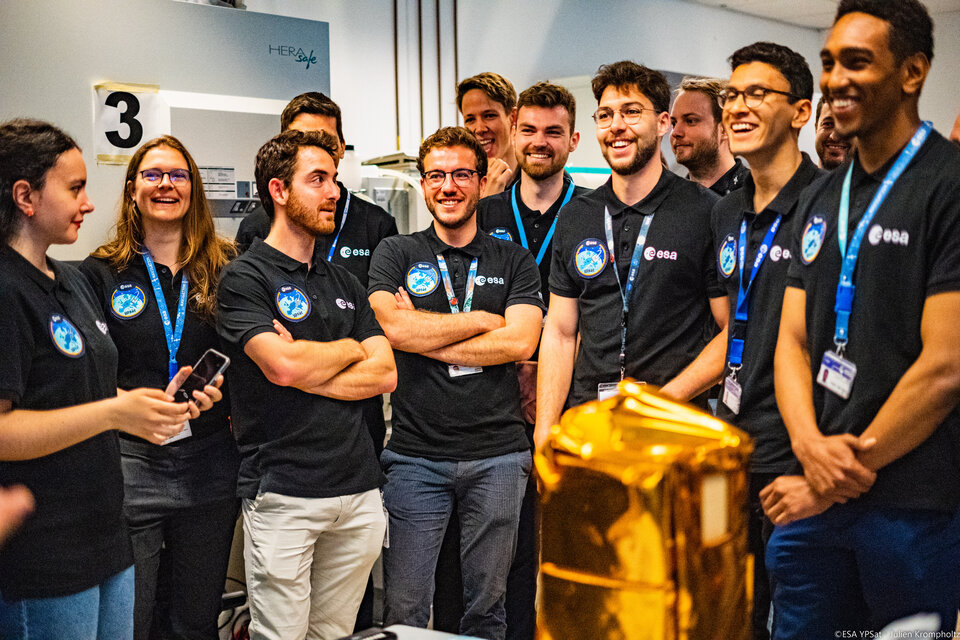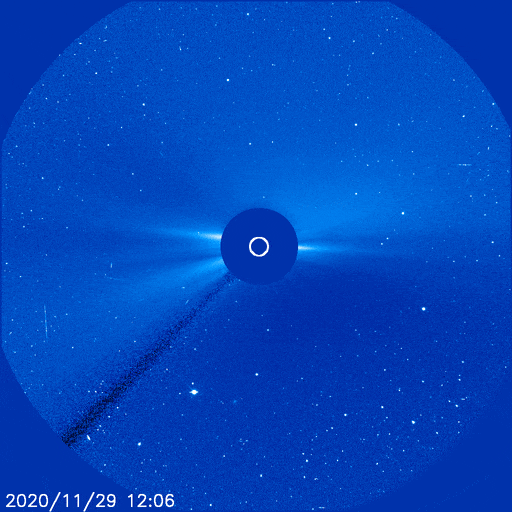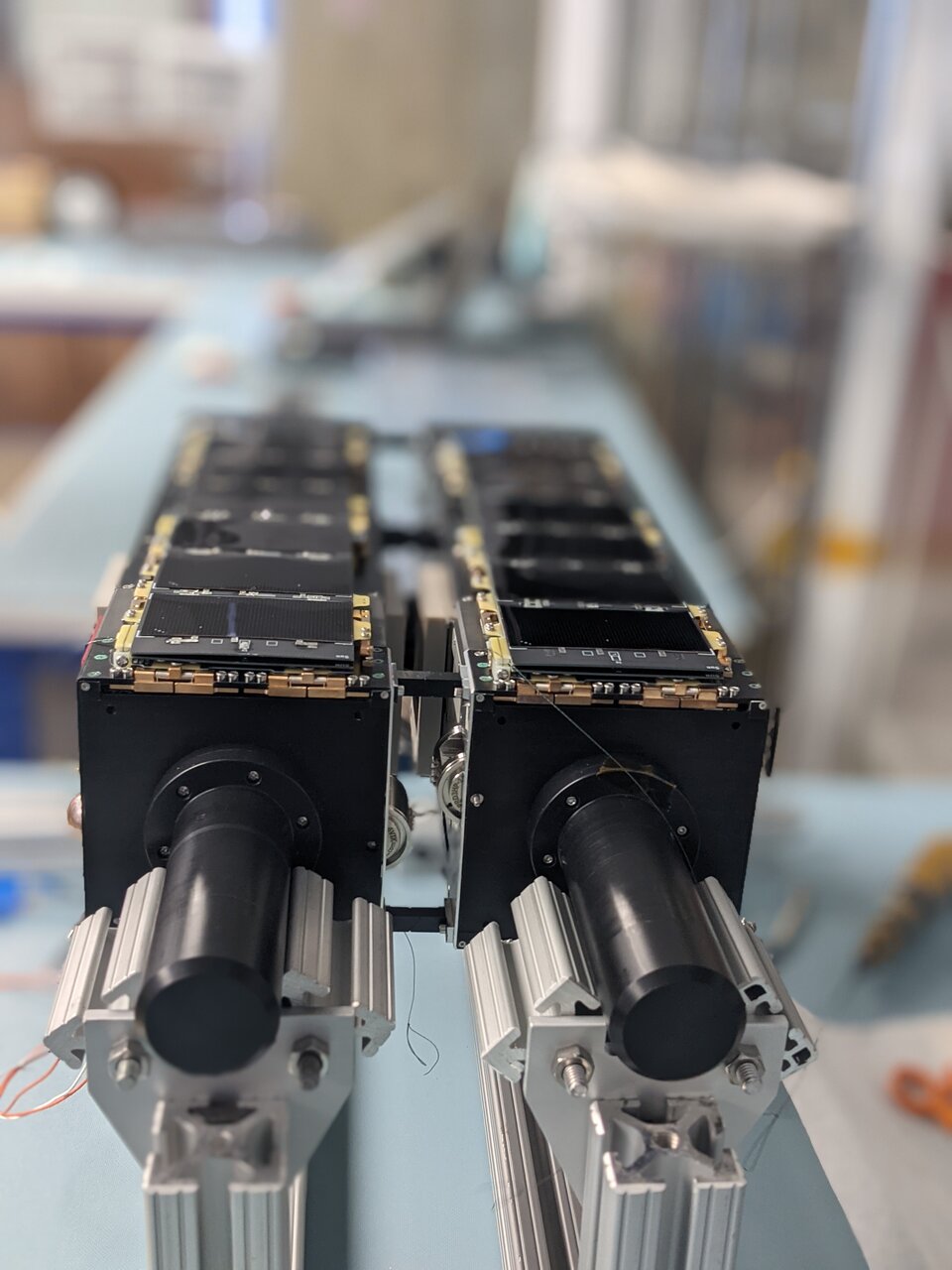28.03.2024
Ariane 6 launches: YPSat ‘the witness’

Europe’s newest rocket soon launches, taking with it many space missions each with a unique objective, destination and team at home, cheering them on. Whether launching new satellites to look back and study Earth, peer out to deep space or test important new technologies in orbit, Ariane 6’s first flight will showcase the versatility and flexibility of this impressive, heavy-lift launcher.

The Young Professionals Satellite (YPSat) will remain attached to the Ariane 6 upper stage, recording the historic flight from the moment the fairing separates and the other passengers first see the darkness of space, to the very end as the stage and satellite deorbit and burn up in Earth's atmosphere. Impressively, it has been entirely designed and built by ESA’s newest space recruits.
YPSat is an initiative from ESA’s very own Young Professionals group who join the Agency in various positions from Graduate Trainees to Junior Professionals, Research Fellows, National Trainees and Student Interns, benefitting from tailored learning and development opportunities to prepare them for a position at ESA or elsewhere in the space sector.

The mission will capture phases of Ariane 6’s inaugural flight – from fairing separation to the deployment of each of its payloads, capturing also views of Earth and space from orbit. YPSat will also offer a platform for ‘host payloads’ such as OscarQube, which will use innovative quantum-based sensors to measure the Earth's magnetic field along the launch trajectory, and AMSAT, an onboard antenna for ham radio communication.
As well as documenting the vital stages of launch and supporting other missions, YPSat gives the team of about 45 entry-level professionals hands-on experience and a high level of responsibility in designing, building and testing space technology.
Two challenges will keep the YPSat team particularly busy once the mission is launched: transmitting YPSat’s data while it remains attached to the Ariane 6 upper stage, and ensuring the spacecraft wakes up earlier than traditional missions do.

"This opportunity to be part of the Ariane 6 inaugural flight puts YPSat at the forefront of a historic moment in European space exploration,” explains Tuur Strobbe, YPSat Project Manager and Graduate Trainee at ESA’s ESTEC technical heart in the Netherlands.
“To make sure our spacecraft eyes are open on time, ready to record Ariane 6's two huge half fairings as they split and separate from the rocket, we've developed a custom autonomous 'Wake up System'. This system uses a variety of sensors to detect the liftoff of the launcher and determine where in the launch timeline we are at that moment, this way we can pinpoint the exact moment for the YPSat mission to begin”.

During the launch, the YPSat team will even be situated in a control room at ESA’s ESOC mission control centre from where they will receive telemetry from their mission.
Once in flight, the team will have to consider the rotation of the rocket as they work to transmit its data home. They will have just one orbit, one shot at successfully retrieving their data, with limited communication windows as the rocket slowly turns.

“I'm so proud of the many groups of young professionals who came together from across all ESA sites to make this possible,” says Lasse Fredagsvik, Leader of Young ESA and Graduate Trainee at ESTEC.
“To have the chance to fly our own mission, with the wise advice and support of the Agency’s knowledgeable workforce, is just a dream come true for us all.”
Ariane 6 is planned to launch in June-July 2024. It follows the hugely successful Ariane 5, Europe's principal rocket for more than a quarter century, flying 117 times between 1996 and 2023 from Europe's Spaceport in French Guiana.

The new heavy-lift rocket has been designed for all possible futures, and at its core is maximum versatility. Ariane 6 can put any satellite or payload into any orbital path. This is made possible with the new restartable Vinci engine that will power up the Ariane 6 upper stage again and again, stopping and starting to insert spacecraft into any orbit they need to be. The launcher stores enough fuel for a final burn, once its passengers are deployed, to deorbit and reenter safely back through Earth’s atmosphere. YPSat will witness it all, recording this historic flight live from the front row.
“It feels unreal that YPSat will soon be launched. It is the climax of months of continuous teamwork in an amazing group that I’m so happy I had the chance to be part of,” says Marilia Matos, Ground Station Coordinator for the mission based at ESA's Italy side, ESRIN.
“It is incredible what the dedication of Young Professionals can achieve! I'm so grateful to have the chance to see something I directly contributed to be launched into space. I cannot wait to see the videos that our payload will produce!”
Find out about all the missions that will be flown on Ariane 6’s first flight and get all the latest in the run up to launch on the Ariane 6 homepage and Space Transport on X.
Quelle: ESA
----
Update: 3.04.2024
.
Ariane 6 launches: NASA’s radio detective CURIE

Europe’s newest rocket soon launches, taking with it many space missions each with a unique objective, destination and team at home, cheering them on. Whether launching new satellites to look back and study Earth, peer out to deep space or test important new technologies in orbit, Ariane 6’s first flight will showcase the versatility and flexibility of this impressive, heavy-lift launcher.

CURIE, the CUbesat Radio Interferometry Experiment from NASA, is one such payload launching on Ariane 6’s first flight. CURIE will measure radio waves coming from the Sun and other radio sources in the sky. Such waves must be measured in space, as they are absorbed by Earth’s ionosphere – a region extending 30 to 600 miles above Earth’s surface composed of ionized (charged) gases and created as solar radiation interacts with the upper atmosphere.

CURIE is made up of two spacecraft that will launch bolted together as one, later separating into two in orbit. From their separate vantage points, the satellites CURIE A and B will make it possible to measure the same radio waves from two locations at the same time. Using the technique of radio ‘interferometric analysis,’ the origin of detected radio waves can be reconstructed.
The principal science objective for CURIE is to use radio ‘interferometry’ to study radio burst emissions from solar eruptions, such as flares and coronal mass ejections in the inner heliosphere. These events drive space weather, its influence being felt on Earth and other planets when they occur, in increasing auroral activity and geomagnetic effects.

CURIE will be able to determine the location and size of radio burst source regions and then track their movement outward from the Sun.
Such a space-based radio interferometry observatory has long been envisioned, in orbit around the Earth or Moon, or on the Moon’s far side. CURIE will be the mission first of its kind to measure radio waves in the 0.1 – 19 MHz frequency range from space. It will serve as an experimental platform and pathfinder in the development of new space-based radio observation techniques important for our understanding of the heliospheric space weather environment, and the Sun’s impact on the planets of the Solar System.
Beyond its important science objectives, CURIE will also prove that the concept of a dedicated space-based interferometer can be realised using relatively cheap CubeSats.

Ariane 6 is planned to launch in June-July 2024. It follows the hugely successful Ariane 5, Europe's principal rocket for more than a quarter century, flying 117 times between 1996 and 2023 from Europe's Spaceport in French Guiana.
Ariane 6 has been designed for all possible futures. At its core is maximum versatility. It can put any satellite or payload into any orbital path. This is made possible with the new restartable Vinci engine that will power up the Ariane 6 upper stage again and again, stopping and starting to insert missions into any orbit they need to be. It will save enough fuel for a final burn to deorbit and reenter safely back through Earth’s atmosphere, or reorbit into a nearby ‘graveyard orbit’.

CURIE will launch into a near-Earth circular orbit, flying at an altitude of 580 km above Earth’s surface and outside of our planet’s radio-absorbing ionosphere.
“When a spot on the first flight of Ariane 6 was made available to us, the CURIE team was very excited. It is such a big event in the world of rocketry and space exploration,” recalls David Sundkvist, principal investigator for the mission.
“For a team that is developing a new concept – a formation flying satellite radio interferometer – launching on the inaugural flight of Europe’s new rocket is like a satellite developer’s dream come true.”
Quelle: ESA
----
Update: 8.04.2024
.
Ariane 6's Maiden launch to deploy Radio Interferometry Experiment for NASA

Europe is poised to launch its newest rocket, Ariane 6, marking a significant advancement in space mission versatility. This inaugural flight is set to carry a diverse array of missions, each with its distinct objective, ranging from Earth observation to deep space exploration and technological experimentation in orbit. Ariane 6 exemplifies the evolution of heavy-lift launchers, demonstrating unmatched flexibility and capability.
Among the payloads is NASA's CUbesat Radio Interferometry Experiment (CURIE), a mission designed to measure radio emissions from the Sun and celestial bodies. Earth's ionosphere, which absorbs these radio waves, necessitates their measurement in space. CURIE, comprising two CubeSats launching as a unified entity and later separating, employs radio interferometry to pinpoint the origins of these emissions simultaneously from dual locations in space.
CURIE's primary goal is to analyze radio bursts from solar activities like flares and coronal mass ejections, which influence space weather affecting Earth and other celestial bodies. By determining the source regions of these radio bursts and tracking their movement, CURIE aims to enhance our understanding of heliospheric space weather and its planetary impacts.
This mission introduces the first space-based radio interferometry observatory capable of capturing frequencies ranging from 0.1 to 19 MHz. CURIE will be key to pioneering space-based radio observation techniques, that are crucial for comprehending the heliospheric environment and the solar system's dynamics.
The mission also underscores the feasibility of deploying dedicated space-based interferometers using cost-effective CubeSats, a significant stride towards advanced space observation technologies.
Ariane 6, succeeding the Ariane 5, is set for its debut launch between June and July 2024. With a legacy of over a quarter century and 117 successful launches, Ariane 5 has been a cornerstone of European space exploration. Ariane 6, with its innovative restartable Vinci engine, introduces unparalleled mission adaptability, capable of delivering payloads into any required orbit and ensuring efficient deorbiting or repositioning strategies.
CURIE is slated for a near-Earth circular orbit at an altitude of 580 km, strategically positioned beyond the ionosphere's radio-interference zone. David Sundkvist, the mission's principal investigator, expressed the team's enthusiasm for participating in Ariane 6's maiden flight, highlighting the significance of this launch for pioneering satellite development and space exploration initiatives.
Quelle: SD
----
Update: 7.05.2024
.
Ariane 6 launches: Exolaunch’s EXOpod Nova

Europe’s newest rocket soon launches, taking with it many space missions each with a unique objective, destination and team at home, cheering them on. Whether launching new satellites to look back and study Earth, peer out to deep space or test important new technologies in orbit, Ariane 6’s first flight will showcase the versatility and flexibility of this impressive, heavy-lift launcher. Read on for all about EXOpod Nova, then see who else is flying first.

Many missions will be hitching a ride into space on Ariane 6’s first flight, but how do you ensure each one is launched from the rocket at the right time and in the right direction? The orchestration of these missions falls upon the shoulders of satellite deployers, tasked with releasing the satellites at the right time.
One of these deployment systems flying on Ariane 6 is from Berlin-based Exolaunch, a global provider of launch services, mission management, satellite integration, and deployment hardware that has successfully deployed over 390 satellites across 28 missions to date.
EXOpod Nova deployer
For Ariane 6’s historic first flight, the company’s EXOpod Nova deployer will carry four CubeSats into space. EXOpod Nova, the size of compact carry-on luggage, will be placed on the Ariane 6 upper stage payload adapter. Crafted from durable yet lightweight aluminium, this deployer can securely house up to 16 units worth of CubeSats, while the deployer itself weighs less than 14 kg without them.

In a bid to accommodate all types of CubeSats, including those surpassing standard dimensions, the EXOpod Nova is designed for versatility. Exolaunch Mission Manager, Nadine Smolka, highlights the company’s dedication to pushing the boundaries of satellite designs, stating, “We aim to revolutionise the industry and make it easier for our customers to explore the limits of their satellite designs.”
Ariane 6 will fly with the EXOpod Nova’s 16 unit version in a three-door ‘S3’ configuration, allowing ample room for four satellites to be positioned. The deployer is intuitive and user-friendly, by design. The EXOpod Nova doors open in response to a signal sent from the Ariane 6 launcher, followed by the push mechanism that releases the satellites into their orbits.
Built in Berlin
Exolaunch’s headquarters and integration facilities are located in Berlin, where the four CubeSats will be integrated into EXOpod Nova. Once complete, the unit then embarks on a transatlantic journey to Europe’s Spaceport, where it will be connected to the Ariane 6 payload adapter. Nadine and other Exolaunch team members oversee the physical attachment and conduct rigorous tests to guarantee flawless functionality before liftoff.

Emphasising their commitment to quality control, Nadine says, “For integration, and in general at Exolaunch, we work on a ‘two brains, four eyes principle’ to ensure quality control — a second teammate to ensure success for all critical operations.”
As a German company with deep roots in spaceflight, Exolaunch takes pride in its European heritage and envisions a booming European space sector. Nadine concludes, “We want to see European space thrive, so we are very excited to see Ariane 6 launch and are honoured to be on board to provide independent access to space for our customers.”
Quelle: ESA
----
Update: 21.05.2024
.
Ariane 6 joint update report, 21 May 2024
The Ariane 6 Launcher Task Force consists of top management of ESA, as the overall Ariane 6 procuring entity and launch system architect, of the French space agency CNES as the launch base prime contractor, of ArianeGroup as the launcher system prime contractor and of Arianespace as the launch service provider. This group reports regularly on progress being made towards inaugural flight of the new Ariane 6 launcher.
Teams are narrowing down the launch period and the first attempt for launch will happen within the first two weeks of July 2024.We are on track and in line with the launch period that was communicated in November.
The tentative date for the first launch attempt will be given at ILA airshow in Berlin, Germany, held from 5 June to 9 June, where all the task force members will be present.
Key milestones towards inaugural flight:
On the way towards the first flight of Ariane 6, these milestones have been conducted since the last joint update:
April 29: Ariane 6 launch system qualification review, Les Mureaux, France
The conclusion of a final all-encompassing review of the Ariane 6 launch system (including launcher and ground segment) was delivered after four-weeks intensive work.
May 16: Payloads arrived in Kourou, French Guiana
The passengers for the first Ariane 6 arrived in Kourou and are being readied for integration.
Next milestones:
Mid-June: Ariane 6 launch system qualification review close-out
The closing of all aspects of the qualification for the Ariane 6 launch system will be approved mid June. This is the final step of the launch system qualification.
June: Upper composite transfer, and integration on the launcher, Kourou, French Guiana
The upper composite, consisting of the launcher adapter, the payloads and the fairing for Ariane 6 flight model-1 will be moved from the encapsulation hall to the launch pad.
June 18: Ariane 6 flight model-1 wet dress rehearsal, Kourou, French Guiana
The Ariane 6 will be fuelled on the launchpad and subsequently drained of fuel in preparation for launch.
Ariane 6 is an all-new design, created to succeed Ariane 5 as Europe's heavy-lift launch system. With Ariane 6's upper stage restart capability, Europe's launch capability will be tailored to the needs of multiple payload missions, for example to orbit satellite constellations. This autonomous capability to reach Earth orbit and deep space supports Europe's navigation, Earth observation, scientific and security programmes. Ongoing development of Europe's space transportation capabilities is made possible by the sustained dedication of thousands of talented people working in ESA's 22 Member States.
Quelle: ESA
